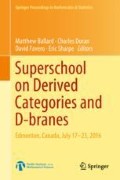Abstract
These notes are for a talk in Superschool on derived categories and D-branes at University of Alberta in summer of 2016. The purpose of these notes is to give a main idea of topological string theories as one of examples of mirror symmetry without any technical details. This means that some definitions are somewhat mathematically less rigorous but we rather show intuitive analyses instead. Readers should be familiar with GR, QFT, SUSY, CFT and some basics of string theories.
Access this chapter
Tax calculation will be finalised at checkout
Purchases are for personal use only
Notes
- 1.
Do not be confused with type (k,l) tensors.
- 2.
This is called a spin connection in supergravity.
- 3.
This is not a coincidence. One can intuitively see from the isomorphism between d-cohomology and \(Q_A\)-cohomology by using the transformation laws of \(\phi , \chi \).
- 4.
This result should be rigorously achieved by the Fadeev-Popov method so that the contracting tensor is suggested to be fermionic and \(G_{zz},\bar{G}_{\bar{z}\bar{z}}\) are the most natural choice.
References
Bouchard V. Lectures on complex geometry, Calabi–Yau manifolds and toric geometry. arXiv preprint hep-th/0702063. 2007 Feb 8.
Vonk M. A mini-course on topological strings. arXiv preprint hep-th/0504147. 2005 Apr 18.
Witten E. Mirror manifolds and topological field theory. arXiv preprint hep-th/9112056. 1991 Dec 19.
Author information
Authors and Affiliations
Corresponding author
Editor information
Editors and Affiliations
Rights and permissions
Copyright information
© 2018 Springer International Publishing AG, part of Springer Nature
About this paper
Cite this paper
Osuga, K. (2018). Introduction to Topological String Theories. In: Ballard, M., Doran, C., Favero, D., Sharpe, E. (eds) Superschool on Derived Categories and D-branes. SDCD 2016. Springer Proceedings in Mathematics & Statistics, vol 240. Springer, Cham. https://doi.org/10.1007/978-3-319-91626-2_15
Download citation
DOI: https://doi.org/10.1007/978-3-319-91626-2_15
Published:
Publisher Name: Springer, Cham
Print ISBN: 978-3-319-91625-5
Online ISBN: 978-3-319-91626-2
eBook Packages: Mathematics and StatisticsMathematics and Statistics (R0)

